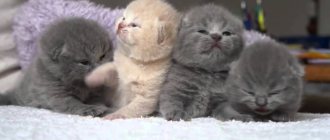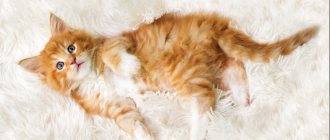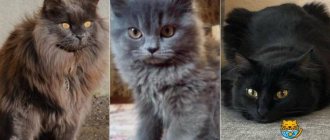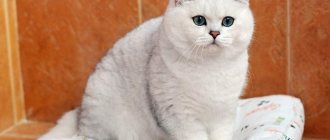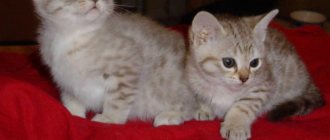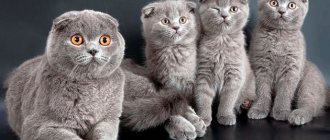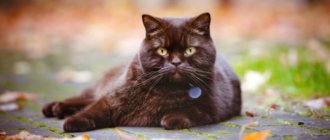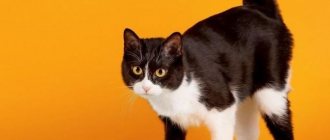A Scottish fold and straight-eared cat at 1 month (4 weeks) is a small creature that needs its mother. Unscrupulous breeders may already give kittens to future owners at this age, because... they want to get their pet early. But such people forget that taking a kitten away from its mother at 1 month is an unacceptable barbarity that can ruin its entire life. In this article we will talk about how a Scottish kitten should look, behave and eat at 1 month old, how to care for it and why it is so important not to separate it from its mother.
The article is part of the section Development of Scottish kittens by month
What does a Scottish Fold and Straight-eared kitten look like?
In the photo below you will see approximately what a Scottish kitten looks like at 1 month. This is no longer a blind creature, which, nevertheless, still feeds on its mother’s milk and is completely helpless without her, and its breed characteristics are not expressed in the same way as at least in a 2-month-old kitten.
Article continues after advertisement
Newborn Scottish Fold and Straight-eared kittens (Scottish Fold and Scottish Straight): photos
Little Scottish Fold and Straight-eared kittens - plush guys: photos (about a week old)
Scottish straight and fold kittens, approximately 3 weeks - 1 month old: photo
Content Features
Cat food
Your pet's diet should be balanced. Preference should be given to ready-made premium and super-premium food. Always have fresh drinking water available. It is not advisable to feed your animal only canned food - this will have a bad effect on the condition of the teeth and gums.
Having made a choice in favor of natural feeding, you need to remember that a cat is a predator, and its diet should consist of at least 40% animal proteins. The pet is given boiled or raw frozen or scalded meat (beef, rabbit, poultry), cereals in the form of porridge (buckwheat, rice), boiled sea fish (once every 2 weeks), vegetables to taste (you should try carrots, zucchini), fermented milk products (low-fat sour cream, cottage cheese, bio-yogurt). Be sure to supplement your diet with vitamin complexes. Pregnancy is an important stage in the life of a Scottish cat. A specially selected diet for the expectant mother must be agreed upon with a veterinarian. A cat should not weigh more than it should during pregnancy, so the pet’s weight must be carefully monitored.
Hygienic care
Scottish Folds do not require special care. However, like other felines, they require regular hygiene procedures, and they must be taught them from childhood. Basic care includes:
- Ear inspection and cleaning twice a month. Ears are a distinctive feature and at the same time a weak point of the breed. They should not be dirty or smell bad.
- The eyes are cleaned with a damp swab as needed.
- Trimming nails as they grow.
- Bathing. Animals with long hair are washed once a month, and animals with short hair – once every 2 months. Zoo shampoo is selected according to the type of coat.
- Combing. The tangles of a Scottish fold long-haired cat are combed out with a special non-prickly brush. First in the direction of hair growth, then against it. Combing the fur is also a kind of massage. This procedure is especially necessary for Highland Folds. However, classic Scottish women also treat her favorably.
Scottish kittens: development from birth
The neonatal period of kitten development lasts from birth to 10 days. This is when the fastest changes occur. At first, the kittens are blind and deaf, sleeping all the time with frequent breaks for food. On days 5-8, kittens develop hearing.
The period when Scottish kittens open their eyes and before they walk is transitional. This period is very important, because the kitten begins to explore the world around it and actively strengthens the musculoskeletal system. During this period, kittens begin to become attached to their mother and their brothers and sisters, and also perceive humans.
From 3 to 10 weeks, the period of socialization lasts, when the kitten actively explores the surrounding space and gets to know people more closely. At this time, the kids already have a noticeable character. The mother teaches the kittens to be clean and follow the rules of hygiene. As you understand, 1 month is 4 weeks, i.e. just the beginning of the socialization stage. Therefore, at this age, a kitten should absolutely not be separated from its mother.
What are the dangers of gross dietary violations?
Overfeeding can lead to premature wear and tear of the gastrointestinal tract, in particular to problems with the liver and pancreas. The same applies to the use of cheap, low-quality feed, since a cat is not a rooster, it cannot digest, for example, low-quality grain.
An attempt to transfer exotic cats raised on food to bones and other products from the human table will only bring negative results. Such an adventure often ends in the death of these animals - they flatly refuse to eat.
Tips from breeders on how to feed kittens correctly are presented in the video below.
Characteristics of age
Kittens at 1 month are still just mastering the world around them. At this time, they begin to actively crawl around their mother and even into neighboring rooms. The mother is not very happy with this, because... The kittens may disappear from sight, so she tries to collect them in a pile. A particularly inquisitive cat may bite its whiskers, because... With the help of their whiskers, cats navigate in space, and, having lost them, they become less self-confident.
Little kittens do not yet know how to go to the litter box, doing it every other time or not doing it at all: many choose the wrong places, contrary to the example of the mother and the complaints of the breeders. But a little more - and these guys will learn everything as required by cat etiquette.
Article continues after advertisement
At the age of 1 month, kittens actively play with each other and with their mother, trying various predatory tricks. But the mother stops their attempts to play with the claws: in this way she develops in the children a manner of playing softly, which future owners will really like. Kittens have not yet mastered this skill at 1 month, so wait at least until 2 months until the mother reinforces it.
What to do if your weight is not normal
If underweight or overweight does not exceed 200 grams, then there is no reason to worry; most likely, the pet simply overate a little or did not move much. But if there is a large deviation from the norm, you need to contact a veterinarian, who will determine the cause and, if necessary, prescribe a course of treatment.
If your weight is below normal
If your Scottish Fold cat's weight at any stage of its growth is significantly below normal, you need to take your pet to a veterinarian. If the animal does not have problems with the gastrointestinal tract, the specialist will prescribe vitamins and give recommendations on changing the diet.
If your weight is higher than normal
Excess weight in a cat often causes the development of serious diseases, so the owner needs to monitor the diet and try not to overfeed the pet. If your pet is already overweight, you should review its diet and gradually reduce the portion size.
You will also have to take care of physical activity - you need to play with the cat more often to burn extra calories.
How to care for a 1 month old Scottish kitten
If up to 1 month the breeder’s task was to feed the mother of the kittens well, because... If they fed exclusively on milk, then from 1 month the task becomes more complicated: you need to feed both mother and babies well. They will continue to be breastfed, but will also receive complementary foods. Some people start by feeding the kittens semi-liquid meat purees, while others are not afraid to give small pieces of raw meat. The second option is correct. Read more about the nutrition of kittens at 1 month in a separate article.
The mother takes care of the rest of the kitten's care, and the breeder only helps her. She handles the toilet herself, licking the babies in all the right places. From 1 month, some breeders already begin to regularly bathe kittens if they have a show career, because... They will have to bathe often and the sooner you start, the better the adult cat will tolerate the procedure. But if there is no need for exhibition, it is quite normal to start bathing at 2-3 months.
As for vaccinations, it is also too early to do them: you need to wait at least 2 months. The fact is that before weaning, kittens are protected by the mother’s immunity.
There are cases when kittens lose their mother at an early age. Then a person must take full care of them. At 1 month, this is a rather difficult task that requires serious skills and patience, but, nevertheless, this task is doable.
The first thing to think about is milk. Kittens receive antibodies from their mother's milk, but without it they become defenseless. Therefore, the ideal option is a nurse cat. If it is not possible to find a wet nurse, you can buy milk from another nursing cat at the veterinary clinic or buy special formulas for kittens, rather than cow or goat milk, which is not very recommended for babies. But at worst you will have to buy cow or goat milk.
The second is a warm, comfortable nest where the kittens will feel completely safe. You will also have to clean the kittens' butts and fur. And also think about their immunity: it is too early to vaccinate them, but they do not have maternal protection, so you will have to create clean conditions, keep kittens away from outdoor shoes and children who have just come from the street and have not washed their hands.
If you are babysitting kittens, then this is a full-fledged maternity leave. Those who have a permanent job should ask their bosses to take time off on maternity leave. Otherwise, kittens are easy to lose.
Description of Scottish folds
Adult Scottish Fold cats are medium in size, with adult males being larger than female cats. The body is slightly elongated and this differs from the stocky type of British cats. The animals' shoulders and hips are the same width. The chest stands out for its volume and considerable width for cats of this size. True Scottish Folds never look fat or clumsy. Their movements are always graceful and easy. The length of the limbs ranges from medium to long. But the paws themselves are noticeably round and graceful.
On average, Scottish Fold cats live 10-15 years
Tail
medium length, it should be proportional to the body.
The tail begins with an expanded base and ends with a blunt tip. Sometimes Scottish Fold kittens have thick and fluffy tails. This feature is accompanied by thickened hind limbs, which affects the gait of the animal. At the dawn of the breed, these signs were considered positive. However, over time, such cats were no longer allowed into exhibitions. Animals with a flexible, movable tail are especially valued in the Scottish breed. This requirement is dictated by the fact that Scottish Fold cats often have joint problems.
Scottish fold cat head
round with well-developed jaws and a strong, rounded chin. The round cheeks on the muzzle catch the eye, which are more pronounced in cats than in cats. The head smoothly turns into a short neck.
Nose
short and wide. At the same time, there may be some slight depression at the junction of the nose and the frontal part. But there is no characteristic “stop”, only a soft bend, noticeable in profile.
Eyes
true Scots have widely spaced, clear rounded shapes. An open look is characterized by expressiveness. In purebred cats, the brow ridges are weakly expressed. If they are well developed, the animal may be disqualified.
Scottish fold cat ears
are the main feature in the breed standard.
The maximum requirements are placed on them. The distance between the left and right ears is quite large - in an adult cat it can be equal to the width of a human palm, and in kittens it can be the width of 3-4 fingers. The ears themselves are small in size and have one, two or even three folds. Due to this, the outer part of the ear is tilted forward and significantly closes the ear canal. By keeping the ears flat, the round shape of the head is maintained. This gives Scottish Folds a cute and slightly doll-like appearance. global $ads_google;
//data-ad-slot=”2475549904″ $ads_google = empty($ads_google) ? false : true; ?> if ($ads_google == false) {?> $ads_google = true; ?> } ?> All Scottish Fold kittens are born with straight ears. It is impossible to determine what an adult pet will be like because babies' ears continue to stand up for several weeks after birth. The shape of the auricle, which is genetically determined, is finally formed only by the age of five weeks. It is worth noting that the more the ears are pressed back, the more their owner is valued in professional circles.
The standard allows wool
short and medium length. The quality is thick, elastic and dense. The skin is soft and elastic to the touch. It is often called plush. But if the animal’s fur is cottony, then this is considered a defect in the breed. The so-called “pants” and thick hairs between the toes on the paws are considered a breed characteristic.
Scottish Fold cats can be any color.
This is one of those breeds for which almost all color options are allowed. Often there are cats of a saturated or lightened shade, but at the same time the same color. Table of popular Scottish Fold colors
| white lilac blue chocolate silver blue cinnamon black | gray peach mackerel fawn smoked silver blue point | red merle color-point cream whiskey chinchilla brown |
The population has multi-colored representatives (harlequin and li van). The Scottish Fold cat with stripes is not considered a rarity. The nature of the drawing may be different:
- tabby;
- spotted;
- marble;
- brindle.
- ticked
- tortoiseshell
Dimensions and weight of fold cats
When born, a small kitten weighs only 65-150 grams and is the size of a palm. Babies require careful care until they get stronger and become independent.
The body length of adult cats and shorthair fold cats is on average 50-55 cm, excluding the length of the tail. With a tail, the size of fold-eared cats can reach 80-90 cm; according to the exhibition standard, it should reach the shoulder blades if folded lengthwise.
The height can reach approximately 29-32 cm when counting from the floor to the withers of a cat standing on four legs.
These sizes are considered average among domestic cats.
Don’t forget about these pet parameters when you are planning to buy accessories: house, carrier, closed tray.
Scottish Fold weight table by month
| Age | Cat | Cat |
| newborns | 65-150 gr | 60-140 gr |
| 1 Week | 230-285 gr | 110-265 g |
| 2 weeks | 330-430 gr | 130-350 gr |
| 3 weeks | 400-630 gr | 210-430 gr |
| 1 month | 430-750 gr | 230-610 g |
| 2 months | 820-1750 gr | 420-950 gr |
| 3 months | 1.5-2.5 kg | 1-1.5 kg |
| 4 months | 2.6-3.9 kg | 1.6-2.4 kg |
| 5 months | 2.7-4.3 kg | 2.1-2.9 kg |
| 6 months | 3-5.4 kg | 2.3-3.6 kg |
| 7 months | 3.3-5.7 kg | 2.4-4 kg |
| 8 months | 3.4-6.1 kg | 2.5-4.3 kg |
| 9 months | 3.8-6.5 kg | 2.5-4.4 kg |
| 10 months | 4.1-6.7 kg | 2.5-4.5 kg |
| 1 year | 4.3-7.3 kg | 2.5-4.7 kg |
| 2 years | 4.3-8.1 kg | 2.5-6 kg |
Diet at 6 months: menu for neutered cats
At six months of age, most kittens undergo a castration procedure. From this point on, the pet’s diet needs to be revised, excluding a number of products from it.
After castration, the likelihood of obesity increases, so due attention should be paid to the nutrition of the Scottish Fold.
Features of feeding castrated animals:
- The menu should include foods enriched with fiber and vitamins.
- Complete exclusion of any type of fish from the diet, since it contains phosphorus and magnesium. Regular entry of these elements into the body of a castrated animal increases the likelihood of urolithiasis.
- Be sure to eat porridge. To make cereals tastier, you can add some lean meat to them.
- By-products - in small quantities, no more than once a week.
- Greens and specially sprouted trauma for cats.
- Vegetables are served only raw. Allowed: carrots, cucumbers, cabbage.
- It is recommended to give your pet low-fat beef broths several times a day.
If the Scottish Fold is on a ready-made food, you need to choose only those that are intended for sterilized and neutered animals. The feed must be of appropriate quality. Preference is given to holistic, super and premium classes.
For other kittens that are not castrated or sterilized, the menu remains the same, only the number of meals per day is reduced.
Vitamins
If the kitten is naturally fed, it must be given vitamin complexes. The emphasis is on fish oil, vitamins A, B and D. Giving your pet pharmaceutical vitamins intended for humans is strictly prohibited. In such preparations the concentration of useful substances is too high, as for animals, for this reason serious complications in the functioning of internal organs can occur.
Kittens who eat only industrial food do not need vitamins. Before choosing vitamin and mineral products, it is recommended to consult a veterinarian. When choosing vitamins on your own, you should choose multivitamins intended for the Scottish breed.
Properly organized nutrition for a new family member - a Scottish Fold kitten - is the key to the fact that the pet will grow up strong and healthy. To choose the right diet, it is recommended to consult a veterinarian, since a specialist will take into account all the characteristics of the breed and the tendency to certain diseases.
Source
